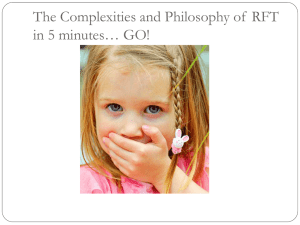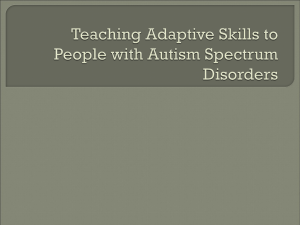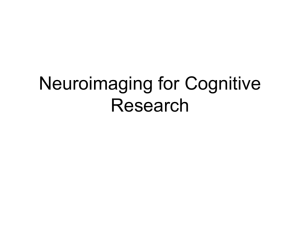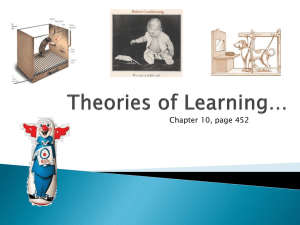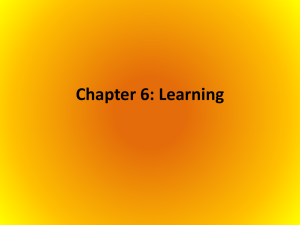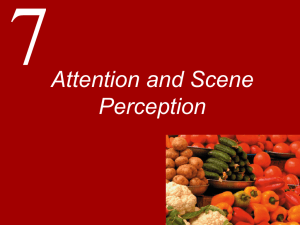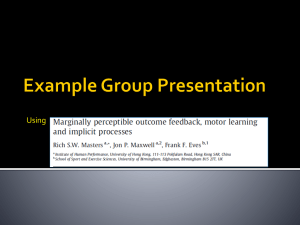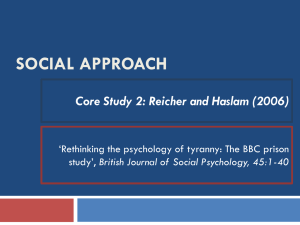Reicher (1969): Word Superiority Effect
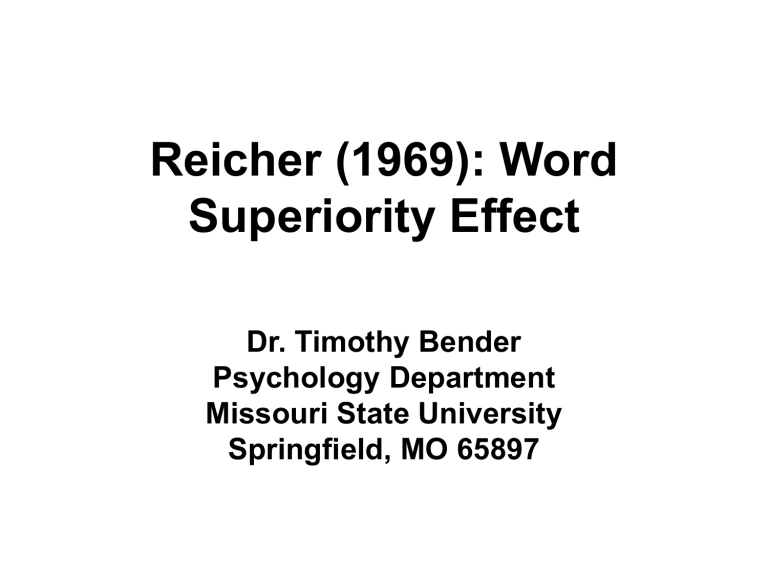
Reicher (1969): Word
Superiority Effect
Dr. Timothy Bender
Psychology Department
Missouri State University
Springfield, MO 65897
Reicher (1969) explored whether or not we use parallel processing in the visual sensory memory. His participants were to identify a single letter that appeared in one of four possible locations. The letter appeared either alone, in a four-letter word, or in a fourletter nonword. All of the stimuli were masked, making it difficult to identify them.
If we process the letters in a word in a serial fashion (one letter at a time), it should be more difficult to identify a letter in a word than that letter by itself.
If we process the letters in a word in parallel (all of the letters at once), it should be just as easy to identify a letter in a word as it is to identify that letter by itself.
The nonword condition allowed Reicher to see if there was something unique about processing a letter in a word vs. that letter in a mixed group of letters.
The results strongly support the idea that we engage in parallel processing in iconic memory. However, Reicher (1969) is most often cited for an additional interesting result which we will discuss after the demonstration.
In this demonstration, you will see a series of 24 stimuli. The stimuli will be either a four-letter word, the same four letters in a mixed order, or a single letter. The single letter will appear in any of the four letter positions from the word condition. The stimulus will appear for about 66 milliseconds and will be followed immediately by a pattern of lines.
Along with the pattern mask you will see a choice of two letters above one of the four letter positions. Your task is to choose which of the two letters appeared in that location in the original stimulus.
The following is an example of a stimulus from the word condition. A + will appear first near the center of the screen, then the stimulus and mask will occur.
Which letter?
The following is an example of a stimulus from the nonword condition. A + will appear first near the center of the screen, then the stimulus and mask will occur.
Which letter?
The following is an example of a stimulus from the letter condition. A + will appear first near the center of the screen, then the stimulus and mask will occur.
Which letter?
The first stimulus will appear on the next slide. You will need a response sheet with the numbers 1 - 24 listed in a column.
For each stimulus, please choose one of the two letter choices, even if you think it is just a guess. Give it your best guess.
Which letter?
The next screen is the next stimulus.
Which letter?
The next screen is the next stimulus.
Which letter?
The next screen is the next stimulus.
Which letter?
The next screen is the next stimulus.
Which letter?
The next screen is the next stimulus.
Which letter?
The next screen is the next stimulus.
Which letter?
The next screen is the next stimulus.
Which letter?
The next screen is the next stimulus.
Which letter?
The next screen is the next stimulus.
Which letter?
The next screen is the next stimulus.
Which letter?
The next screen is the next stimulus.
Which letter?
The next screen is the next stimulus.
Which letter?
The next screen is the next stimulus.
Which letter?
The next screen is the next stimulus.
Which letter?
The next screen is the next stimulus.
Which letter?
The next screen is the next stimulus.
Which letter?
The next screen is the next stimulus.
Which letter?
The next screen is the next stimulus.
Which letter?
The next screen is the next stimulus.
Which letter?
The next screen is the next stimulus.
Which letter?
The next screen is the next stimulus.
Which letter?
The next screen is the next stimulus.
Which letter?
The next screen is the next stimulus.
Which letter?
You will score your performance next.
You will have three scores, one for each type of stimulus. You will first figure your
Letters score. Give yourself 1 point for each of the following that you answered correctly.
2. L
6. C
8. V
12. V
13. G
17. Y
19. T
23. D
Figure out the mean score for the class.
You will now figure your Nonword score.
Give yourself 1 point for each of the following that you answered correctly.
3. V 7. Y 15. D 20. C
4. G 10. T 18. L 22. V
Figure out the mean score for the class.
You will now figure your Word score.
Give yourself 1 point for each of the following that you answered correctly.
1.Y
9. D 14. C 21. V
5. T 11. L 16. V 24. G
Figure out the mean score for the class.
If your class performed similarly to the participants in Reicher (1969) you scored better in the Word condition than in either the
Nonword or Letter conditions. In other words,
Reicher found that it is easier to recognize a letter in a simple word than it is to recognize that letter alone or in a nonword!
This has been called the Word
Superiority Effect.
If your class’s did not show the Word
Superiority Effect, do not worry. Reicher’s participants performed the task as individuals in a much better controlled environment than the classroom. Also, they were pretested to determine the optimal presentation speed for each participant.
One other difference between this demonstration and Reicher’s (1969) research is that in addition to the single word, nonword, and letter conditions, Reicher used two-word, two-nonword, and two-letters conditions. In other words, his participants had to pay attention to 8 different positions on the screen rather than just 4.
You are strongly encouraged to read the original article for a better understanding of the research.
One popular attempt to explain the Word
Superiority Effect is the interactive activation model of McClelland & Rumelhart (1981).
Basically, they suggest that both feature processing and word processing provide additional support to letter processing.
Therefore, when a letter appears in a word, the letter is recognized more easily than when the letter appears alone or in a nonword.
References
McClelland, J. L., & Rumelhart, D. E. (1981). An interactive activation model of context effects in letter perception: Part 1. An account of basic findings. Psychological
Review, 88, 375-407.
Reicher, G. M. (1969). Perceptual recognition as a function of meaningfulness of stimulus material. Journal of
Experimental Psychology, 81, 275-280.

